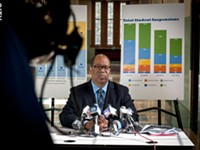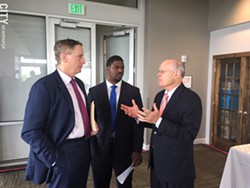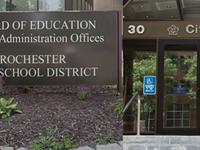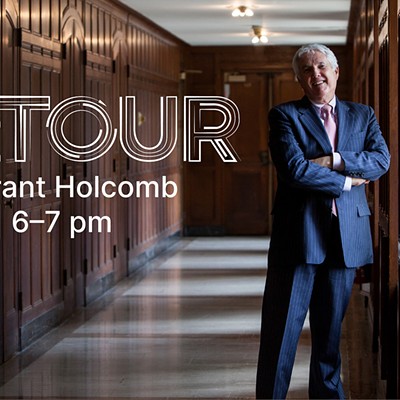[
{
"name": "500x250 Ad",
"insertPoint": "5",
"component": "15667920",
"parentWrapperClass": "",
"requiredCountToDisplay": "1"
}
]
Some teachers, parents, and community members have speculated that the current focus on fixing Rochester's schools could present an opportunity to greatly expand the number of charter schools in the area, and charter school advocate David Osborne certainly made a case for it on Thursday. He led an all-day conference, "Lessons From Other Cities: School Quality as an Equity Strategy," that was presented by the Greater Rochester Chamber of Commerce.
The timing couldn't have been more perfect for those arguing for a change in how city schools are governed. Adrian Hale, workforce and economic development manager with the Chamber, said the timing of the conference had nothing to do with the current conversation about city schools. Hale said planning for the event began a year ago.
Osborne is among many education advocates who argue that the typical public school systems were designed for another era. Though the systems aren't a detriment in more affluent communities, they're out of touch with the needs of urban students with fewer family resources, he said. The typical urban public school struggles with a system that is centralized and rigid, avoids competition, and leaves parents with little choice. Often teachers and staff in urban schools feel demoralized, Osborne said.
"People who feel disempowered almost never give you 100 percent," Osborne said.
Osborne cited New Orleans' school system, which has become almost entirely a charter school system in the aftermath of Hurricane Katrina, as one of the best examples of how a failing traditional public school system can be transformed in a relatively short time.
However, there's a long backstory of problems to the New Orleans example. Put simply: the hurricane, which devastated the city and its schools, provided an opportunity to overcome political barriers to changing the school system. Before Katrina, 60 percent of New Orleans students attended a school that ranked in the bottom 10 percent of Louisiana schools in terms of performance scores. A decade later, only 13 percent did, according to Osborne.
Roughly half of public school students dropped out each year before the storm, and fewer than one in five went on to college. In 2015, 76 percent graduated from high school within five years, a point above the state average. In 2016, 64 percent of graduates entered college, six points above state average.
There has been some concern about the data coming out of New Orleans, particularly around possible demographic changes and how they could be impacting results. But an analysis by an economics professor at Tulane University determined that the impact of those changes is minimal.
Osborne cited the Washington, DC, school system as another district that has dramatically improved during the last 15 years. The DC schools had long been among the country's worst performing, and the city got off to a rocky start with charter schools. Though the DC school system underwent sweeping changes under education reformer Michelle Rhee, her efforts were enhanced by a more rigorous review of charter school performance.
The latter, Osborne said, makes all the difference in how well charter schools perform compared to traditional public schools. States with agencies that critically review charter school applications and keep an eye on results are extremely important, he said. New York and Massachusetts have tough review cycles, while states like Ohio and Michigan do not, he said.
Indianapolis and Springfield, Massachusetts, have school systems that are closer in size and demographics to Rochester's, Osborne said. And they've developed systems that include large numbers of charters. For instance, about a third of Indianapolis students attend district charters, and they outperform the city's traditional public schools. More recently, the State of Indiana targeted persistently low-performing Indianapolis schools for state takeovers. They have become what that city calls Innovation Network Schools. They operate autonomously under the supervision of an outside agency. If they meet their goals during five-year intervals, they stay open. If not, they're closed.
Osborne stressed that dramatic changes in how schools operate has to be accompanied by a community-wide sense of urgency; without it, he said, complacency and finger-pointing will flourish. It's better to do something and risk failure than to do nothing, in his view.
The Rochester area now has 14 charter schools and those schools have enrolled about 6,000 city school district students. Some of those students will return to city schools because few charters serve Pre-K through 12th grade.
There are some areas where Rochester's charters are clearly outperforming city schools, most notably testing in math and English. The test scores are an indicator of whether students will not only graduate and enroll in college also whether students will need remedial courses once they're there.
A problem, though, is that charters nearly everywhere, including here in Rochester, need space. And the growth of charters is contributing to the need. Students don't leave one city school and go to a charter school. They're leaving multiple schools at the same time. Some eventually return, which is making it difficult for school administrators to predict space needs. Some classrooms can be crowded while others have too few students in the same building.
And while charters can theoretically be better managed, they're also small and nimble school systems that are a fraction of the size of the Rochester school district. They strengthen the argument for shrinking large urban school districts like Rochester's into smaller organizations.
But perhaps the most worrisome challenge charters present for Rochester is what happens to schools and students who are left behind. Greater Rochester Chamber of Commerce's promotional materials for the event gave an excellent overview of Rochester's public schools and their problems. It describes the success of charter schools in the 2017-2018 school year.
It also said, "Charter schools on average served significantly fewer percentages of economically disadvantaged students, English language learners and students with disabilities than district schools." Put another way, as charter schools have grown, it's increasingly clear that the Rochester school district will be left with more students who are challenging and costly to educate.
Still, it's easy to see why Osborne's advocacy for charter schools can be so appealing to a community that is angry with the status quo and calling for change. Improvements appear to happen more quickly and traditional concerns with labor — tenure, seniority, and easy terminations — are greatly diminished.
The timing couldn't have been more perfect for those arguing for a change in how city schools are governed. Adrian Hale, workforce and economic development manager with the Chamber, said the timing of the conference had nothing to do with the current conversation about city schools. Hale said planning for the event began a year ago.
Osborne is among many education advocates who argue that the typical public school systems were designed for another era. Though the systems aren't a detriment in more affluent communities, they're out of touch with the needs of urban students with fewer family resources, he said. The typical urban public school struggles with a system that is centralized and rigid, avoids competition, and leaves parents with little choice. Often teachers and staff in urban schools feel demoralized, Osborne said.
"People who feel disempowered almost never give you 100 percent," Osborne said.
Osborne cited New Orleans' school system, which has become almost entirely a charter school system in the aftermath of Hurricane Katrina, as one of the best examples of how a failing traditional public school system can be transformed in a relatively short time.
However, there's a long backstory of problems to the New Orleans example. Put simply: the hurricane, which devastated the city and its schools, provided an opportunity to overcome political barriers to changing the school system. Before Katrina, 60 percent of New Orleans students attended a school that ranked in the bottom 10 percent of Louisiana schools in terms of performance scores. A decade later, only 13 percent did, according to Osborne.
Roughly half of public school students dropped out each year before the storm, and fewer than one in five went on to college. In 2015, 76 percent graduated from high school within five years, a point above the state average. In 2016, 64 percent of graduates entered college, six points above state average.
There has been some concern about the data coming out of New Orleans, particularly around possible demographic changes and how they could be impacting results. But an analysis by an economics professor at Tulane University determined that the impact of those changes is minimal.
Osborne cited the Washington, DC, school system as another district that has dramatically improved during the last 15 years. The DC schools had long been among the country's worst performing, and the city got off to a rocky start with charter schools. Though the DC school system underwent sweeping changes under education reformer Michelle Rhee, her efforts were enhanced by a more rigorous review of charter school performance.
The latter, Osborne said, makes all the difference in how well charter schools perform compared to traditional public schools. States with agencies that critically review charter school applications and keep an eye on results are extremely important, he said. New York and Massachusetts have tough review cycles, while states like Ohio and Michigan do not, he said.
Indianapolis and Springfield, Massachusetts, have school systems that are closer in size and demographics to Rochester's, Osborne said. And they've developed systems that include large numbers of charters. For instance, about a third of Indianapolis students attend district charters, and they outperform the city's traditional public schools. More recently, the State of Indiana targeted persistently low-performing Indianapolis schools for state takeovers. They have become what that city calls Innovation Network Schools. They operate autonomously under the supervision of an outside agency. If they meet their goals during five-year intervals, they stay open. If not, they're closed.
Osborne stressed that dramatic changes in how schools operate has to be accompanied by a community-wide sense of urgency; without it, he said, complacency and finger-pointing will flourish. It's better to do something and risk failure than to do nothing, in his view.
The Rochester area now has 14 charter schools and those schools have enrolled about 6,000 city school district students. Some of those students will return to city schools because few charters serve Pre-K through 12th grade.
There are some areas where Rochester's charters are clearly outperforming city schools, most notably testing in math and English. The test scores are an indicator of whether students will not only graduate and enroll in college also whether students will need remedial courses once they're there.
A problem, though, is that charters nearly everywhere, including here in Rochester, need space. And the growth of charters is contributing to the need. Students don't leave one city school and go to a charter school. They're leaving multiple schools at the same time. Some eventually return, which is making it difficult for school administrators to predict space needs. Some classrooms can be crowded while others have too few students in the same building.
And while charters can theoretically be better managed, they're also small and nimble school systems that are a fraction of the size of the Rochester school district. They strengthen the argument for shrinking large urban school districts like Rochester's into smaller organizations.
But perhaps the most worrisome challenge charters present for Rochester is what happens to schools and students who are left behind. Greater Rochester Chamber of Commerce's promotional materials for the event gave an excellent overview of Rochester's public schools and their problems. It describes the success of charter schools in the 2017-2018 school year.
It also said, "Charter schools on average served significantly fewer percentages of economically disadvantaged students, English language learners and students with disabilities than district schools." Put another way, as charter schools have grown, it's increasingly clear that the Rochester school district will be left with more students who are challenging and costly to educate.
Still, it's easy to see why Osborne's advocacy for charter schools can be so appealing to a community that is angry with the status quo and calling for change. Improvements appear to happen more quickly and traditional concerns with labor — tenure, seniority, and easy terminations — are greatly diminished.
Speaking of...
Latest in News
More by Tim Louis Macaluso
-

RCSD financial crisis builds
Sep 23, 2019 -

RCSD facing spending concerns
Sep 20, 2019 -

Education forum tomorrow night for downtown residents
Sep 17, 2019 - More »









